The engine cooling system is liquid, closed type, with forced circulation of the liquid.
The system consists of a cooling jacket in the cylinder block and cylinder head, a radiator with an electric fan, a heater radiator, an expansion tank, a water pump, a thermostat and hoses
The circulation of fluid in the system is created by a water pump. From the pump, liquid is supplied to the engine cooling jacket, washes the cylinders, combustion chambers, throttle assembly, heater radiator (at low temperatures) and then enters the thermostat.
Depending on the position of the thermostat valve, the liquid enters the cooling jacket (at low temperatures) or the radiator (at high temperatures).
A radiator with a horizontal fluid flow, with a tubular-tape aluminum core and plastic tanks. There is a drain cock at the bottom of the left radiator tank.
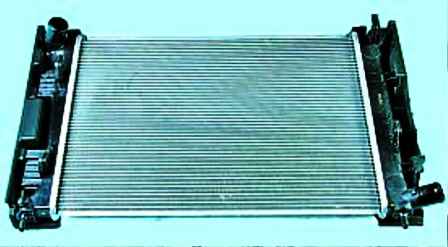
In the tanks there are inlet and outlet pipes of hoses to the engine water jacket and the filler neck.
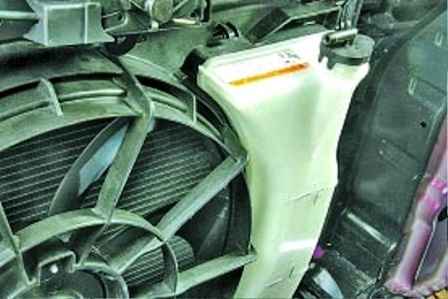
The expansion tank is used to compensate for the changing volume of the coolant depending on its temperature.
It is made of translucent plastic.
Reservoir body is marked "F" (full) and "L" (low) to control coolant level.
The tank is connected by a hose to the radiator filler neck.
The centrifugal-type water pump provides forced circulation of fluid in the cooling system, is installed on the front surface of the cylinder block and is driven by a V-ribbed belt from the crankshaft pulley.
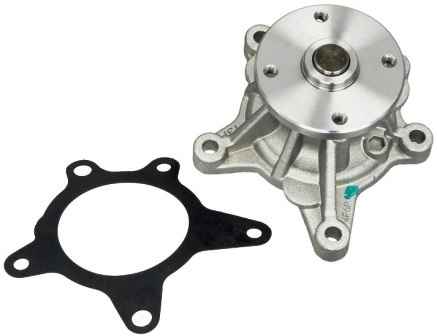
The pump has sealed bearings that do not require relubrication.
The pump is replaced if there is radial play on the pump shaft or coolant leaks from the control hole
The pump cannot be repaired, therefore, in case of failure (liquid leakage or damage to the bearings), it is replaced as an assembly.
Thermostat with a solid temperature-sensitive filler maintains the normal operating temperature of the coolant and reduces the warm-up time of the engine.
The thermostat is installed in a housing fixed to the cylinder head.

At a coolant temperature of up to (82 ± 1.5) ° C, the thermostat is completely closed and the liquid circulates along a small circuit, bypassing the radiator, which accelerates engine warm-up.
At a temperature of (82±1.5) °C, the thermostat begins to open, and at 95 °C it opens completely, providing fluid circulation through the radiator.
Typically, the thermostat is replaced when the valves are stuck either in the open position or in the closed position
In the closed position, if the valve is stuck, the engine overheats, the coolant flows in a small circle, bypassing the engine cooling radiator
If the thermostat is stuck open, the engine is not warming up enough or taking too long to warm up
The electric fan of the cooling system (with a plastic impeller) is used for additional airflow to the radiator, it turns on and off at the signal of the electronic engine control unit.
Moreover, depending on the intensity of the thermal regime and the algorithm of the air conditioner, the electric fan can rotate at low and high speeds.
Changing the fan speed is provided by the engine control unit by connecting an additional resistance.
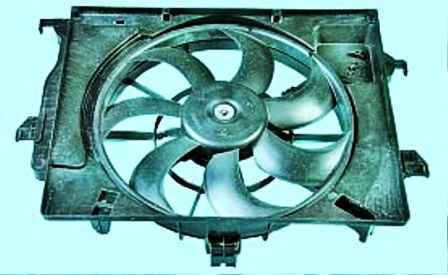
The electric fan assembly with the shroud is mounted on the radiator of the cooling system.
The system is filled with a liquid (antifreeze) that does not freeze at ambient temperatures down to -40 ° C.
System capacity cooling 5.3 liters
Possible malfunctions of the cooling system and methods of elimination
Engine is overheating
Low coolant level in expansion tank - Add coolant
Thermostat defective (valve stuck closed) - Replace thermostat
Water pump defective - Check pump and replace if defective
Radiator core clogged with dirt and insects - Rinse the outside of the radiator core
Radiator pipes, hoses and engine cooling jacket clogged with scale and sludge - Flush the cooling system and fill with fresh coolant
The electric fan does not turn on due to a break in the electrical circuits of the sensors, failure of the sensors, relay or fan motor - Check and repair the electrical circuits. Replace sensors, relay or fan assembly if necessary
Damage of the valve in the radiator filler cap (the valve is constantly open, due to which the system is under atmospheric pressure) - Replace the filler cap
Continuous drop in coolant level in the expansion tank
Expansion tank leaking - Replace expansion tank
The radiator is leaking - Replace the radiator
Coolant leaks through leaky pipe and hose connections - Tighten the hose clamps
Water pump seal damaged - Replace water pump
Water pump housing gasket damaged - Replace gasket
Insufficiently tightened cylinder head bolts (during a long stop on a cold engine, coolant leaks at the junction of the cylinder head with the cylinder block, in addition, traces of coolant may appear in the engine oil) - Tighten the cylinder head bolts as necessary torque (see How to replace a Hyundai Solaris engine head gasket).
Replace the damaged gasket, restore the tightness of the plugs
Leaking heater core - Replace heater core
The engine overheats, cold air comes out of the heater
Excessive coolant level drop due to leaking or damaged cylinder head gasket causing vapor lock in the engine water jacket - Repair the coolant leak.
Replace damaged cylinder head gasket
The engine does not warm up to operating temperature for a long time
Thermostat is defective (the valve is stuck open) - Replace the thermostat
Coolant change
We prepare the car and install it on a lift or a viewing ditch
Before changing the coolant, you must wait until the engine has cooled down so as not to burn yourself with vapors or the liquid itself
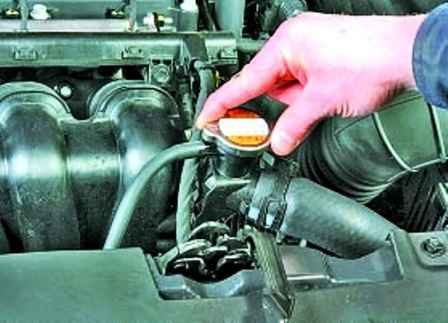
Turn the filler cap of the radiator of the engine cooling system by 90°
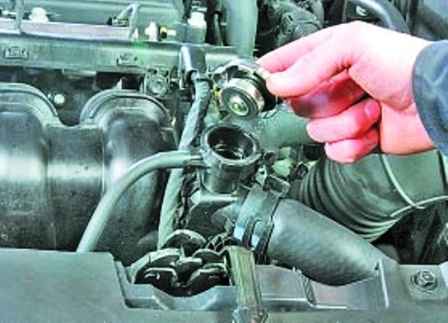
And remove the cork
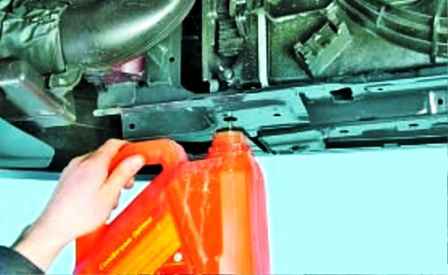
We substitute a container for draining the liquid under the radiator valve of the cooling system, which is located in the lower left part of the radiator

Unscrew the drain cock plug two or three turns and drain the liquid and the radiator
Tightening the drain plug
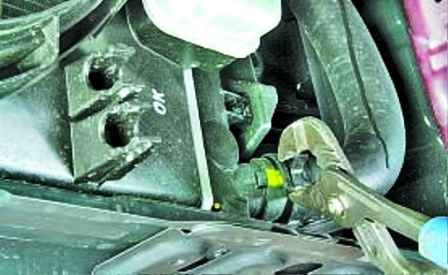
Squeeze the clamp of the lower radiator hose with pliers and slide the clamp along the hose

Remove the hose from the pipe of the radiator tank and drain the liquid from the engine into the prepared container
Installing the lower radiator hose

Open the cap of the expansion tank and remove the remaining coolant from the tank using a rubber bulb or a technical syringe.
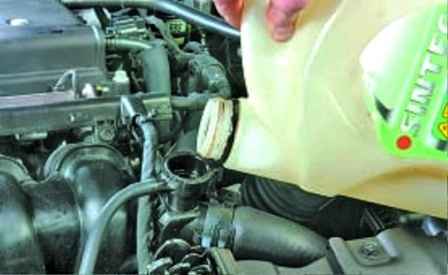
We fill the engine cooling system by pouring coolant into the radiator filler neck until it starts to overflow from the neck into the hose to the expansion tank.
Tightly close the filler cap
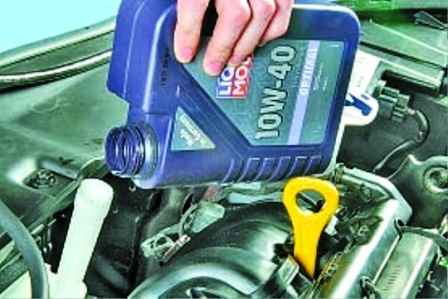
Pour fluid into the expansion tank up to the “F” mark on the tank wall
Start the engine and warm it up to operating temperature (before turning on the fan)
Then we stop the engine and, if necessary, add liquid to the expansion tank to the “F” mark
While the engine is running, watch the coolant temperature using the gauge.
If the pointer has reached the red zone, and the radiator fan does not turn on, turn on the heater and check how much air passes through it.
If the heater supplies heated air, the fan is most likely defective, and if it supplies cold air, then an air lock has formed in the engine cooling system.
To remove it, turn off the engine, let it cool and unscrew the filler cap.
Start the engine, let it run for 3-5 minutes and close the filler cap.
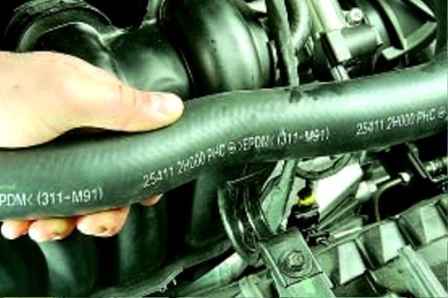
To better fill the system without air pockets, periodically squeeze the radiator hoses with your hand.
After a few days of vehicle operation, after replacing the coolant, check its level.
Replenish the level if necessary.
If after a very short time the color of the fresh liquid turns brown, it means that you filled in a fake, in which the manufacturer "forgot" to add corrosion inhibitors.
In addition, one of the signs of a fake is a sharp complete discoloration of the liquid.
Good quality coolant dye is very stable and will only darken over time.
The liquid, tinted with linen blue, is discolored. This "antifreeze" needs to be replaced faster.





